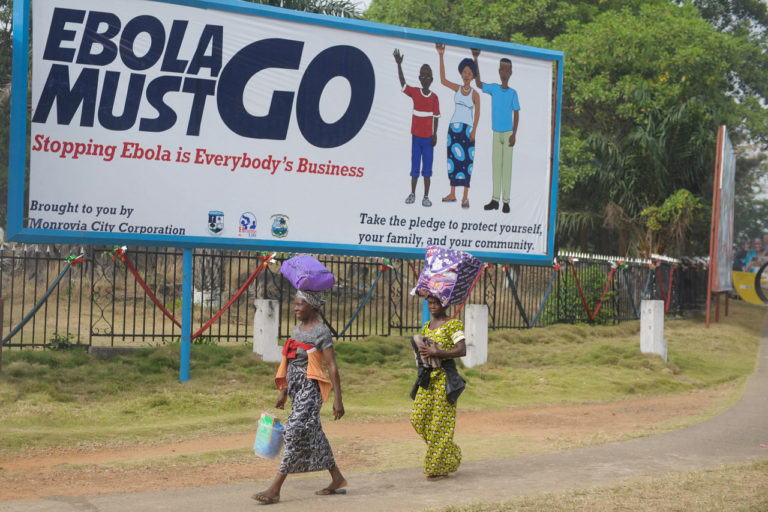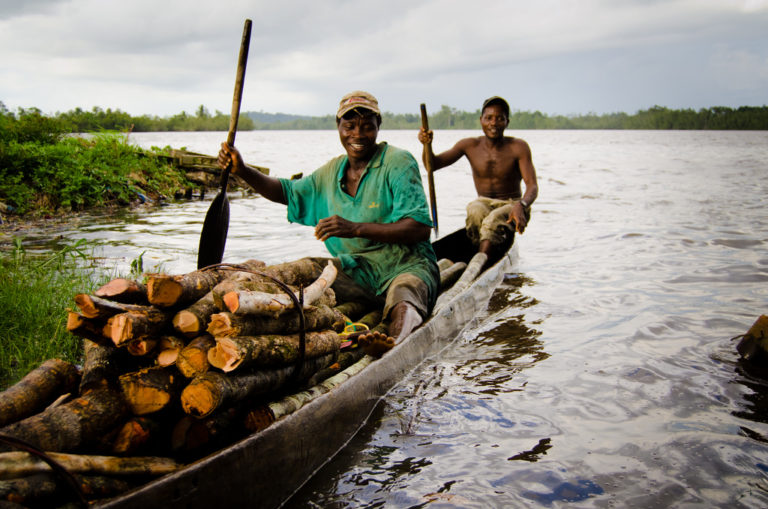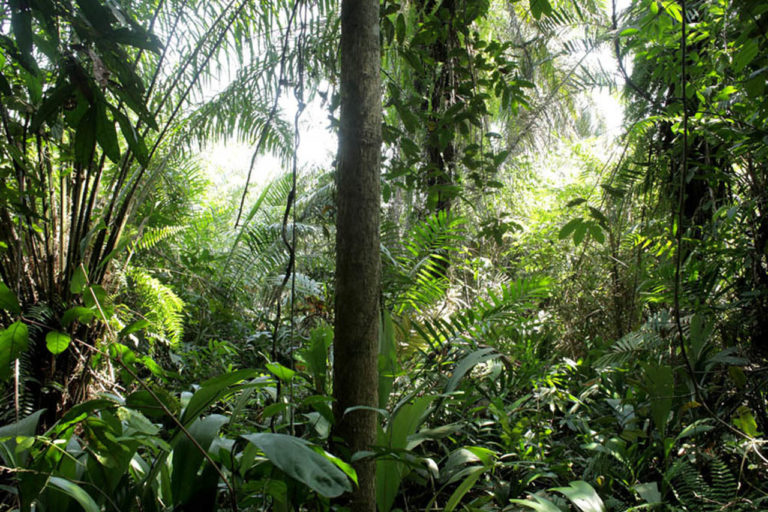- Liberia holds 40 percent of West Africa’s Upper Guinean rainforest.
- National and international organizations have worked with communities and the country’s leadership to clean up the corruption that many say has pervaded outside investments in timber and commercial agriculture.
- Currently, the Land Rights Act, which would give communities more control over their forests, awaits approval, but its progress has been paralyzed, in part by this year’s elections.
It’s no secret that natural wealth in many African countries often sparks conflict and precipitates decades of the suffering of local populations. Liberia’s ‘resource curse’ is no different.
With more than 40 percent of the remaining Upper Guinean rainforest, the West African nation’s timber was the currency that financed a bloody 14-year civil war. Now, nearly 15 years after the end of the violence, the country continues to struggle in sorting out how best to use its forests to provide a boost to one of the world’s poorest economies.
“The stakes are pretty high because there’s this link back to the conflict,” said Michael Beevers, a professor of environmental studies at Dickinson College in Pennsylvania who studies the conflict. The concern, he said, is that “if forests aren’t managed well, perhaps there could be a reversion back to conflict or lots of low-level conflicts.”

Charles Taylor, who led the rebellion that began in 1989, funneled revenue from selling timber, as well as diamonds, iron ore, and rubber, into weapons purchases and building his own wealth. When he was elected president of Liberia in 1997, Taylor maneuvered so that eventually he had near-full control of Liberia’s resources, and he struck deals with companies willing to overlook an on-going civil war that killed 250,000 people and the human rights abuses of his regime.
But even after the end of the war, control of Liberia’s forests remained in the hands of the government, not in the communities that depend on them. The international community, aiming to buoy the devastated Liberian economy – the war had shaved off more than 89 percent of its gross domestic product by 1995 – took a similar tack.
The hope was that centralized control of timber resources, along with safeguards to ensure that the timber could not be used to stoke conflict, would encourage foreign investment. Then, the resulting job opportunities would trickle down, and the new economic development would improve living standards.
That didn’t happen. Despite being given 1.6 million hectares of land for oil palm, timber, and mining, companies’ promises to invest in community development have gone unmet, according to researchers and NGOs.
Shocks to the system
Liberia remains one of the world’s poorest countries, bereft the resilience to absorb the impact of jolts like the 2014 Ebola outbreak. It ranked 177th out of 188 countries in the UN Development Program’s Human Development Index in 2015, and the growth of the country’s gross domestic product, a key economic indicator, was negligible.
Though deforestation remains low according to the Global Forest Resources Assessment 2015 for Liberia by the Food and Agriculture Organization, recent actions by the government have induced a backlash by communities, human rights organizations and NGOs. Between 2010 and 2012, officials granted logging licenses for nearly 60 percent of the country’s remaining untouched forests and covering around 25 percent of the land in Liberia. Many, if not most, were found to have been granted illegally, indicating widespread corruption. The scandal led President Ellen Johnson Sirleaf to impose a moratorium on logging permits in the country in 2013.
“They are playing on the weak governance we have,” said James Otto, program leader for the community rights and corporate governance program at the Sustainable Development Institute (SDI), a Liberian NGO focused on natural resources.
“We have people in government who should be standing [at] the door and asking more questions and engaging with the companies,” Otto added.
Because communities have not yet been empowered with a say in what happens to their land, he said that they’ve often been backed into deals that benefit big companies and no one else. He pointed to the acquisition of thousands of hectares of land for oil palm plantations by the Singapore-based company Golden Veroleum Liberia, known as GVL, from communities wracked with Ebola in 2014.
According to The Guardian, the company got ahold of approximately 13,000 hectares in just two months at the height of the epidemic.
“We were in crisis,” Otto told Mongabay. “There was Ebola. People were not supposed to come together and sit in meetings.” In fact, President Sirleaf had banned public meetings to reduce the chance of spreading the disease.
GVL told The Guardian in 2015 that the signings of the memoranda of understanding with these communities was just the final step in a process that had begun before Ebola broke out in Liberia.

A push for community control
In the last decade, a groundswell of support for community control of forests has been building in the country. In step with research showing the importance of communities in forest conservation around the world, community advocates have been fighting for the passage of the Land Rights Act since 2009.
“For the last 14 years, there’s been a real push to give communities more control and look at community rights as a central part of what’s happening in forests in Liberia,” Beevers said.
The idea is to bring communities into the fold, allowing them some control over how their land is used. In nearly seven years of debate, the proposed law, which would move control over Liberian land from the Forestry Development Authority to the Land Commission, has gained the support of President Sirleaf and many lawmakers in government, as well Liberians around the country, Otto said.
“It has been a resounding story across the country that they want ownership rights,” he added. “That has come out very clearly and strongly in almost all the community and regional consultations – that you give our land back to us, and this is the recipe for development and moving the country forward.”
“I think it will lead the way for community benefits,” said Jeremiah Karmo, the director of the Forestry Training Institute and one of the authors of the 2015 FAO forests report.
And it comes at a time when Liberians are developing a better understanding of this resource. “We are about to undertake a national forest inventory by next year. That will give us a good measure of what we have concerning our forests’…carbon,” Karmo said.
Supporters of the Land Rights Act got a big boost when Norway promised $150 million to help stop deforestation, with payments coming through 2020 contingent upon Liberia’s reductions in carbon emissions. In addition to the climate change goals that these payments are meant to help achieve under the international strategy of “reducing emissions from deforestation and forest degradation in developing countries,” or REDD+, the Norwegian agreement stipulates that some of that money must be used to bolster community forest management institutions.
Instead of pushing a top-down agenda, just as the international community and the emphasis on timber extraction did after the civil war, these new multinational pacts support existing institutions and sentiments in the country, Beevers said.
“They can start creating new norms [and] new behaviors that can be positive,” he added.
The country has also signed a voluntary partnership agreement, or VPA, with the European Union’s Forest Law Enforcement, Governance and Trade, known as FLEGT, facility. The agreement to ensure that timber arriving from Liberia to the EU is sustainably and legally harvested came into force in 2013.
While the country is still in the process of implementing the reforms necessary to obtain full licensing from FLEGT, foresters in the country say that it’s already making a difference.
“[The VPA is] helping to build our capacities with staff members,” said Joseph Tally, technical manager for the commercial forestry department at the Forestry Development Authority.

Concerns about the Land Rights Act
Tally also voiced concerns about the Land Rights Act and whether Liberians comprehend what the move might mean.
“We hope that they understand that turning the forest completely over to the [Land] Commission that [doesn’t] have foresters or the knowledge of the forest,” Tally said. “They are turning the entire land over to communities and then we see there will be a conflict with the Forestry Development [Authority] also having a mandate to take care of the forest, to ensure that the forest is well supervised.”
The Forest Development Authority is a government agency created by the Liberian Legislature in 1976 and is charged with managing Liberia’s forests.
It appeared as if the Land Rights Act might pass in the second half of 2016, but progress has since stalled. And with Liberian’s going to the polls in October 2017, SDI’s James Otto said that politicians’ focus will likely be on getting reelected.
“This government might not have the will or the time to pass the Land Rights Act,” Otto said.
One of the reasons that the Land Rights Act has spent so much time in limbo is that many people are not sure how such diffuse control over a resource as large as the forests will play out.
Beevers, who studies resource management after conflict and has written extensively about Liberia, said the results of such a sweeping move are difficult to predict.
“There’s a worry that if communities have the final say, if they initiate anything, that things like protected areas could go away, because maybe they don’t want a protected area,” Beevers said. “There’s a worry that [the law] could work against conservation and biodiversity protection.”

“At the same time, communities say, ‘Well, [forest management has] never worked anyway. It’s never benefited communities.’”
What’s more, he added, the inclusion of many different viewpoints as communities’ voices are heard will be difficult. And concerns about shady practices by logging companies linger.
“The more actors you bring to the table, the harder it is,” he said. “But in general that’s the best way to go.
“If you’re building trust [and] you’re building cooperation amongst all these different actors, that’s where you’re going to get more of the trajectory towards peace, rather than a trajectory toward contentiousness and conflict.”
The long process toward sorting out forest policy in Liberia has demonstrated how contentious issues making progress in land rights, conservation and economic development can be. But to Beevers’ mind, progress on these issues shouldn’t be viewed as a singular end goal.
“I think we need to look at these issues as an on-going conversation,” he said. “That’s how we should be thinking about governance and managing resources.”
And despite the difficulty, the fact that Liberia is sorting these issues out is a testament to how far Liberia has come.
“This is a conversation that was completely impossible 10 years ago, and certainly before that,” Beevers said. “In the past, this discussion would never have happened.”
CITATIONS:
• Beevers, M. D. (2015). Forest governance and post-conflict peace in Liberia: Emerging contestation and opportunities for change? Extractive Industries and Society, 3(2), 320–328. https://doi.org/10.1016/j.exis.2015.07.007
• Beevers, M. D. (2015). Governing Natural Resources for Peace: Lessons from Liberia and Sierra Leone. Global Governance: A Review of Multilateralism and International Organizations: April-June 2015, Vol. 21, No. 2, pp. 227-246.
• FAO. (2015). Global Forest Resources Assessment 2015. FAO Forestry.
• Stevens, C., Winterbottom, R., Springer, J., & Reytar, K. (2014). Securing Rights, Combating Climate Change: How Strengthening Community Forest Rights Mitigates Climate Change. Washington DC: World Resource Institute, 64.
FEEDBACK: Use this form to send a message to the author of this post. If you want to post a public comment, you can do that at the bottom of the page.


